

Using Manual Focus Lenses on Canon EOS bodies
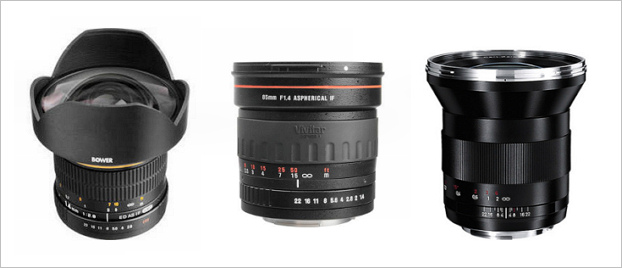
Left:Bower fisheye manual focus Center: Vivitar 85/1.4 manual focus Right: Zeiss 21/2.8 manual focus
A common question from Canon EOS owners is whether older manual focus lenses from other manufacturers can be used with a Canon EOS body. The answer is a qualified "yes" in many cases. Of course you don't get autofocus, nor do you get any sort of focus confirmation unless you use a special adapter with built in electronics. In addition you don't get any sort of automatic iris operation.
Stop Down Metering
In most SLRs and DSLRs, focusing is done at full aperture, and if you set the aperture to, say, f11, it remains fully open until just before exposure, then it stops down for the exposure and opens up again. This gives a brighter viewfinder image and makes focusing easier and more accurate. For almost all manual focus lenses, this stopping down during exposure is accomplished mechanically via a lever which is moved as the cameras mirror flips up. The Canon EOS system bodies have no means to do this. The EOS lens interface is fully electronic and Canon EOS EF and EF-S series lenses are stopped down via electrical signals from the camera When a mechanical iris lens is mounted on an EOS body, stop down metering must be used. That means that the lens is first focused at full aperture (for maximum accuracy), then manually stopped down to the shooting aperture before the shot is taken.
Focusing
Focusing the lens is another issue. Many people have trouble accurately focusing using the standard EOS viewfinder screen, since it has no focus aids (like a split image center). While special manual focus aided viewfinder screens are available for a few EOS bodies, in most cases you have to depend on the original screen. It is possible to get accurate focus, but you need a properly aligned viewfinder screen and good eyesight. A viewfinder magnifier is often helpful.
Alternatively, most current DSLRs have a live view capability, which displays the actual image from the sensor on the rear LCD in real time, often with the option of magnifying the image. This is the best and most accurate method of judging focus. The only downside is that it's time consuming and you can't do it with the camera up to your eye.
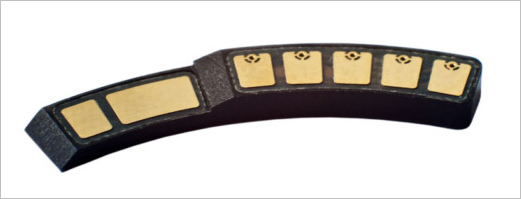
AF confirmation chip
A third alternative is to use a lens adaptor with what is called an "AF confirmation chip" attached. This is a small electronic chip in a molded housing with contacts that connect with the electronic lens contact pins in the Canon EOS camera body. Essentially it fools the body into thinking that an EOS EF/EF-S series lens is attached and the lens has been switched into manual focus mode. Under these conditions the camera body activates the "green dot" autofocus confirmation light in the camera viewfinder, so that you get the in-focus indication and "beep" when you have the lens focused on the subject.
.jpg)
AF confirmation chip attached to adapter
While many people have had good luck with the AF confirmation chips and chip enabled adapters, there have been a few reports that they have damaged cameras. I have used three of them from different sources (all via eBay) and I have had no issues with any of them. If you are going to attach a chip to an existing adapter it's very important to glue it in exactly the right spot so that the contacts on the chip align properly with the pins of the camera.
There are several types of AF confirmation chips. The simplest just tell the camera it's OK to activate the AF confirmation light and send a fixed focal length and aperture (usually 50mm f2) to the camera. Others can be programmed with a focal length and aperture using the camera to do the programming. Some can be focus calibrated. Make sure you know what you are getting if you buy one. The most popular source is, of course,eBay.
Exposure and Metering
When using a manual focus lens on an EOS body there are two exposure modes which will work correctly, Manual and Aperture Priority. In manual mode you set both the shutter speed (via the EOS body) and the Aperture (via the aperture ring on the lens) yourself. In Aperture Priority mode you set the aperture on the lens and allow the EOS body to determine the shutter speed.
Since a mechanically adapted manual focus lens has no intrinsic electrical coupling to the body, the body doesn't know it's there and so with most current EOS bodies the LCD display will readout an aperture of "00". This is normal. don't worry about it. Some older EOS film DSLR bodies will display "1.0", and this can be changed with the usual aperture control dial to anything you want. However you want it set to "1.0". Do NOT dial in the aperture you are using on the lens. Leave it at "1.0", and if it changes to something else (some bodies will change this value when switching between modes), change it back to "1.0".
As mentioned earlier, some adapters have a built in focus conformation chip. In that case the chip is usually programmed to tell the EOS camera body and aperture. It might be f1.4 or f1.8 or something else. The camera will then display that aperture, but you can safely ignore it. The camera will measure the amount of light actually coming through the lens and in aperture priority will calculate the appropriate shutter speed. It will not use the displayed aperture for any exposure calculation (though it will record it in the image EXIF data.
Though autoexposure will work just fine, some EOS bodies may require some degree of exposure compensation - or not. There's really no way to tell without doing some tests. You can either shoot, look at the results, then decide if compensation is needed. This is easy with digital, but tedious to do with film. The other way is to compare meter readings for the same scene between the manual focus lens and a regular EOS lens. At the same aperture both should give the same shutter speed. If they don't, add exposure compensation in the case of the manual focus lens until they do. I've found most lenses are pretty good, but a few do need exposure compensation set. The reason for this is complex and has to do with the relative positions of the exit pupil of the lens and the optics of the autoexposure sensors.
Clearly using a manual focus lens is inconvenient, but sometimes it can be worth it if the equivalent EOS lens is expensive, if the manual focus lens is better than any Canon EF or EF-S series lens (rare, but it happens), if you shoot mostly static subjects or if you don't use the lens very often.
Multipliers/Teleconverters
The use of multipliers with adapted lenses is a little complex. When you mount a Canon multiplier (teleconverter) on an EOS body there is communication between them. The multiplier basically tells the body "Hey, I'm a multiplier and whatever you see through me should look like a valid, operational, autofocus Canon lens". If you don't mount a lens on the multiplier that says "hey, I'm a canon EOS compatible lens", the camera body gets upset and refuses to work! In fact if you just mount the multiplier and try to take a shot, you'll find the camera will refuse or report an error condition. It wants to see an EOS lens on there.
If you have a manual focus lens on an adapter with a focus confirmation chip built in, things should be OK. The lens then tells the multiplier and camera that it's OK and it's a compatible lens, which makes the camera happy again and it will work.
If you use a multiplier safe for the lens in the original lens mount, e.g. an M42 multiplier on an M42 lens or a Nikon multiplier on a Nikon lens, and then mount the adapter on the multiplier you should have no problem. The camera body doesn't mind in this case because there's no intermediate Canon multiplier telling the camera body to expect a Canon lens.
If all else fails and you have a lens mounted on a canon multiplier and the camera won't fire, you can slightly dismount the multiplier by rotating it a small amount (as though you were removing it from the camera). This disrupts the communication between the multiplier and the camera and the camera is happy again. Just don't rotate the multiplier too far or it will fall off the camera!
The lens detection Microswitch
On some EOS bodies there is a small microswitch in the lensmount which must not be tripped by any attached lens or lens adapter in order for the camera body to work. If an adapted manual focus lens trips this microswitch, the camera body them looks for a valid EF series lens to be attached. If it doesn't see the correct electrical connection the the camera body thinks there is an error condition and will not operate. I've never been able to find an official list of which bodies have this switch and which don't. The early 1D series bodies do, up to the 1D MkII. The 1D MkIII doesn't. I think the D30, D60 and 10D have it too (note that's the D30/D60 not the later 30D/60D). Some, possibly all, EOS film bodies have it. I know the EOS-3 does for example.
If you have one of the bodies with this microswitch and your adapted lens causes the camera to freeze you have to remove a small part of one of the bayonet flanges in order to avoid tripping the switch. Either that or do not lock the adapter completely in the EOS mount. If you don't fully rotate it so that it "clicks" into place it won't trip the switch. Of course the adapter is them not fully locked onto the camera, so you need to be careful not to accidentally allow the lens to part company with the camera!
Canon EOS Lens Adapters
Flange to Focal Plane Distance
The focus of a lens is determined by the distance from the lens to the sensor. A mechanical adapter which allows a lens to be mounted on an EOS body and focused to infinity is only possible if the lens is designed to focus an image at a distance greater than that between a standard EF series lens and the sensor in the EOS body. This is because you need some space for the mechanical adapter between the EOS body and the lens. If the lens is designed to focus an image at a shorter distance then an EOS EF lens, then the manual focus lens would have to be put inside the EOS body! The distance from the mounting flange on the back of the lens to the film (or digital sensor) is known as the "Flange Back", or the "Flange to Focal Plane" distance, or sometimes as the "Flange to Film" distance.
Here's a list of flange-to-focal-plane distances. For all Canon EOS cameras it is 44.0mm, which is shorter than most other major cameras. This enables (in theory) lens adapters to be constructed for the lenses shown in green below. Lenses shown in red (which includes all Canon FD and earlier lenses) cannot be mounted on an EOS body and still reach infinity focus without some intermediate optics.
| Canon EOS | 44.0 mm | Adapters |
| Contarex | 46.0 mm | Mechanical adapters with no optics and which maintain infinity focus may be possible |
| Contax RTS | 45.5 mm | |
| Leica R | 47.0 mm | |
| Nikon | 46.5 mm | |
| Olympus OM | 46.0 mm | |
| Pentax K | 45.5 mm | |
| Pentax Screw (M42) | 45.5 mm | |
| Petri Bayonet | 45.5 mm | |
| Ricoh Bayonet | 45.5 mm | |
| T2 mount | 55.0 mm | |
| Yashica FR, FX | 45.5 mm | |
| Canon (FD and earlier) | 42.0 mm | Adapters would need optics for infinity focus and act as weak multipliers |
| Fujica X Mount (bayonet) | 43.5 mm | |
| Konica F | 40.5 mm | |
| Minolta MD | 43.5 mm | |
| Miranda | 41.5 mm |
In addition, since medium format lenses are normally located much further from the film than 35mm lenses, it should be possible to mount just about any medium format lens on an EOS body via a suitable adapter. Adapters are available for Hasselblad, Pentacon-6, Kiev, Mamiya 645, Pentax 645 and Pentax 67 lenses and all should focus to infinity without a problem. The only exception might be a few superwide lenses which require the camera mirror to be locked up for use. You can find such medium format adapters on eBay if you can't find them from the usual vendors (Amazon, Adorama, B&H etc.).
Mechanical Lens Adapters (no optics required)
Mechanical adapters (i.e. adapters containing no optics) could be made for any of the lens mouts shown in green in the table above. I have seen adapters advertised for sale to adapt Nikon, Olympus OM, Leica, Contax/Yashica, Pentax Screw (M42) and "T" mount lenses to a Canon EOS body. Prices range from around $20 for the simple Pentax Screw and $10 for "T" mounts, up to over $200 for the more complex and harder to find adapters.
If all else fails, Cameraquest have most adapters, but their prices are high. $200 for most adapters and even $125 for the simple Pentax screw (M42) to EOS adapter. Another place to look is Ebay, where there are many people selling inexpensive adapters made in China. Their quality varies, but the price is usually right.
Though it looks like Pentax K-mount lenses should be adaptable to an EOS body if you just consider the flange to focal plane distance of PK lenses, it turns out that the diaphragm coupling lever which sticks out from the back of the lens causes problems. On most EOS bodies you would have to remove this lever. However APS-C Sensor EOS bodies which can take EF-S lenses [all after the EOS 10D) can take adapted Pentax-K lenses without the need to remove the aperture coupling lever. There's is more room inside the EF-S capable body and the reflex mirror of APS-C sensor cameras is smaller, so there's less chance of interference. The adapters are available on Ebay for around $10-$40 (the more expensive ones have focus confirmation circuitry) and there are a number of sources. Some claim that they will work with any EOS body, not mentioning any modification of the lens, but I'd be suspicious of such claims. Others warn that they only work with unmodified lenses with APS-C (crop sensor) DSLRs designed to accept EF-S series lenses.
The following adapters are known to exist. Others may exist, this is not an exclusive list. All EF series adapters will work on EF-S, but EF-S adapters will not work on full frame bodies without risking damage to the reflex mirror.
- Bronica ETR medium format
- Bronica SQ medium format
- Contax/Yashica SLR
- Hasselblad medium format
- Leica R
- Leica Visoflex
- Mamiya 645 medium format
- Nikon F Lenses with Aperture Rings
- Nikon G (and non G) Lenses without Aperture Rings
- Olympus OM
- Pentax 42 Screw Mount
- Pentax K (to EF-S)
- Pentax PDA (to EF-S)
- Pentax 645 medium format
- Pentax 67 medium format
- Tamron Adaptall
- T-mount
Lens adapters with Optics
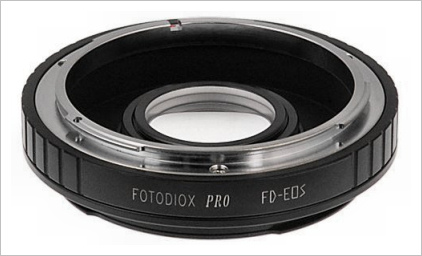
Canon FD to EOS adapter containing optics to enable infinity focus
Lenses with mounts shown in the table above in red would not be able to focus to infinity without optics in an adapter. While purely mechanical adapters are possible, and in fact are available, lenses mounted via such adapters would not be able to focus to infinity. The focus limit for each lens would be different and could range between anything from a few feet to a few tens of yards.
Adapters with optics are available for a number of lens mounts, including Canon FD lenses, often at fairly low cost. For example Pro Optic Canon FD Lens to EOS Body Adapter - around $50 at Adorama. The problem is that the optics in these lenses are rarely equal to the optics in the lenses and so image quality suffers. In addition they also act as weak multipliers, so your excellent 50mm FD lens might become an average 70mm or 80mm lens when mounted on an EOS body via an inexpensive optical adapter unless it's stopped way down. However if you have a bag full of Canon FD lenses it might be worth experimenting with an FD to EOS adapter
The following optical adaptors are known to exist (it's a short list!):
- Canon FD (e.g. Pro Optic adapter
- Minolta MD (e.g. Fotodix adapter)
Although it should be possible to make a Konica to EOS mount with optics that allowed infinity focus, I've never seen one and I've never even heard of one. I guess Konica lenses are not that popular, plus Konica has just about the shortest flange to focal plane distance of any 35mm SLR lens and so the optics would need to be stronger than for either Canon FD or Minolta MD lenses. It's a pity because there are some rather nice Konica lenses out there. If you have Konica lenses your best bet is the Olympus four-thirds system. Konica to four-thirds adapters require no optics and can readily be found.
Genuine CANON brand FD lens adapters
Canon have actually made two adapters for mounting Canon FD mount lenses on an EOS body. The first is a purely mechanical adapter (the "Lens Mount Converter FD-EOS"), and so lenses will not focus to infinity. They can, however, be used for macro work. The second adapter is designed for the following FD lenses and allows infinity focus:- FD 200mm 1.8 L
- FD 200mm 2.8 RF
- FD 300mm 2.8 L
- FD 300mm 4
- FD 300mm 4 L
- FD 400mm 2.8 L
- FD 400mm 4.5
- FD 500mm 4.5 L
- FD 600mm 4.5
- FD 800mm 5.6 L
- FD 50-300mm 4.5 L
- FD 85-300mm 4.5
- FD 150-600mm 5.6 L
Elephoto FD to EOS adapter
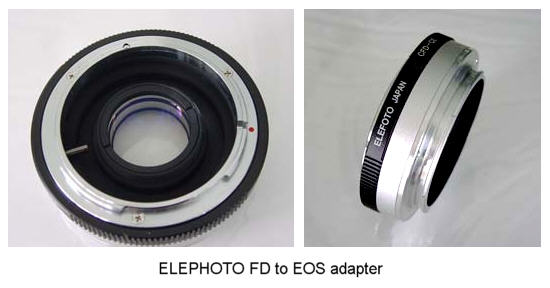
Elephoto made an FD to EOS adapter that was somewhat better than the cheap generics, but not as good as the Canon (however it was a lot cheaper!). I don't believe it's still in production though. See Elephoto FD to EOS adapter for a review I wrote when it first came out.

Other Lens Adapters - Tamron Adaptall and T-mount
Tamron Adaptall
One other series of manual focus lenses can be used on EOS bodies, and that is the Tamron "adaptall" series. These lenses can be mounted on just about any camera body via the appropriate "adaptall" adapter. Tamron make many such adapters, in fact they make one for most major SLR lines. They even made one for Canon EOS. Note I said the "made" one, not they "make" one, since they stopped making it a long time ago. They are now very hard to find.The good news is that more recently other people have started making copies of the Tamron Adaptall mount for EOS. Before such Adaptall mounts were available, there was a workaround. Here it is:
T-Mount
Before Tamron developed their Adaptall mounting system they introduced the simpler T-mount so that any T-mount lens could be attached to any DSLR. While the Adaptall system has mechanical coupling to the aperture control of the lens, the T-mount was just a simple uncoupled screw thread. The T-mount looks a lot like the M42 Pentax screw mount, but it's not the same. The T2-mount has an M42x0.75 metric thread (0.75mm thread pitch) while the M42 has an M42x1.0 metric thread (1mm thread pitch). Be aware of the difference. Don't try to screw a T-Mount lens into an M42 adapter (or vice-versa). It will start to screw on OK but if things seem very stiff after a turn or so, check you have the right adapter for the lens. If you force things with the wrong adapter you will damage the threads.
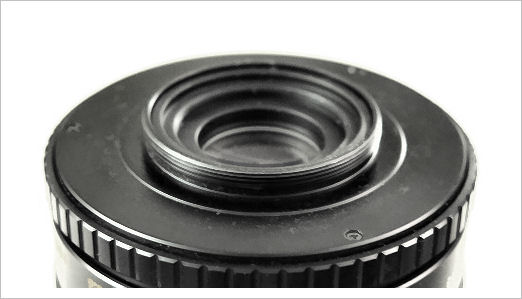
T-mount lens. It looks like an M42 Pentax screw thread, but it isn't. The two aren't the same
T-mounts are generally a simple mechanical coupling between a lens and camera. Just a screw thread. No levers to couple aperture settings, no automatic stop down on shooting, no mechanical contacts, no focus drive. No electrical or mechanical information is passed from the lens to the camera.
There was an early (1957) T mount, officially designated as the T1 mount, with a M37x0.75 thread but these lenses don't show up much. I've never actually seen a lens with the original T1 mount - or a T1 mount adapter - though I'm sure they exists. When people talk about T-mount lenses and adapters, they almost always are referring to the T2 mount which was introduced around 1962. Most of the T mount lenses you are likely to come across are from the early 1960s and 70s, though there are still a few T-mount lenses in production today (2013). They tend to be low cost "generic" lenses. A lot of cheap 500/8 mirror lenses use a T-mount. Some Russian lenses also come in a T mount.
Many telescope and microscope T- mount adapters are available. Since it's so simple, the T mount system can be used for connecting almost any optical system to a camera. T-mount adapter rings (which attach to the camera) are cheap and available for just about any camera.
Here's a brief list of some of the manual focus lenses I've successfully used on both EOS film and digital bodies:
- Pentax 50/1.4 (Pentax Screw)
- Pentax 55/2.0 (Pentax Screw)
- Peleng 8/3.5 fisheye (Pentax Screw)
- Zenitar 16/2.8 fisheye (Pentax Screw)
- Tamron 500/8 Mirror (Tamron Adaptall mount)
- Vivitar 500/8 mirror (T-Mount)
- Tamron 17/3.5 (Tamron Adaptall mount)
- Tamron 24/2.5 (Tamron Adaptall mount)
- Tamron 28/2.8 (Tamron Adaptall mount)
- Jupiter-9 85/2 (Pentax Screw)
- Pentacon 135/2.8 (Pentax Screw)
- Soligor 35/2.8 (T-Mount)
- Vivitar 19/3.8 (Pentax Screw)
- Various telescopes (T-Mount)
Is there any point in using manual focus lenses?
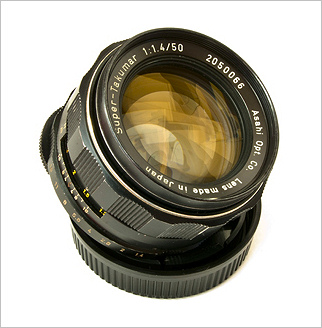
Pentax 50mm f1.4 Super-Takumar M42 mount - $75-$125 on eBay
(credit: http://commons.wikimedia.org/wiki/File:Asahi_Pentax_Takumar_50mm_1-4.jpg#filelinks)
I think the answer is generally no, not unless you have to for reasons of cost or unless you just like playing around with old lenses. However there are a few circumstances in which using an older (or newer) manual focus lens might make sense. For example if you want a 500/8 mirror lens, you have no choice but to use a manual focus lens, either a new lens made in an EOS mount or an older lens adapted to EOS. The other reason might be cost saving for a special lens like a fisheye. Since fisheye lenses barely need focusing (they have a huge depth of field) and since they're a lens that most people would only use very occasionally, it makes sense to save money and get a manual focus lens for about 1/3 the cost of an AF version. On the other hand there's really no point in adapting a 50mm lens since the Canon EF 50/1.8 II costs around $100 new, yields high quality images, has AF and a camera controlled aperture. You can argue that the optical quality of an older manual focus lens might be better that that of a similar EF lens, but I haven't found that really to be the case, at least with comparable optics. For example the two Pentax 50mm lenses (50/1/4 and 55/2) I've tested were really no better performers than the Canon EF 50/1.8 II. The f1.4 is 2/3 stop faster though.
You can find some very inexpensive Pentax screw mount lenses. For example for under $30 you can probably find "generic" branded 28/2.8, 35/2.8, 135/2.8 and any number of 50mm lenses from f1.4 to f2. If you just want to experiment, these lenses and an M42 to EOS adapter offer a very cheap route. Optical quality may not be the highest, but then neither is the cost.
New Manual Focus lenses with EF compatible mounts
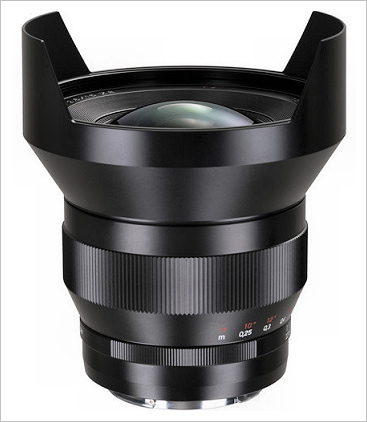
Zeiss Distagon T* 15mm f/2.8 ZE in a Canon EF mount
Some people suggest that some manual focus lenses are better then their Canon AF equivalents. For example the manual focus Zeiss 21mm f2.8 is sais to be significantly better than the Canon 20/2.8 or any of the wideangle zooms which cover 21mm, and is, in fact, one of the very best wideangles available, especially in terms of corner and edge sharpness. I can't confirm this myself since I haven't personally used one, but I see no reason why it couldn't be true and it certainly appears to be the case judging from image samples I've seen posted on the web. However, it will cost you around $1700 new (the Canon EF20/2.8 is closer to $400), so it's certainly not a cheap or convenient route to optical quality!
Zeiss now have a line of lenses in an EOS mount, but still with no autofocus. However with some of the lenses the aperture is coupled to the camera and all existing exposure programs (P, AV, TV, M) and the AF verification function of the camera are supported, and lens information (focal length and speed) is passed on to the camera and can be recorded in the image EXIF data fields. They'd better be good because they certainly aren't cheap!
- Zeiss Distagon T* 21mm f/2.8 ZE Lens for Canon EF Mount - $1843
- Zeiss Makro-Planar T* 100mm f/2 ZE Lens for Canon EF Mount - $1843
- Zeiss 15mm f/2.8 Distagon T* ZE Series Lens for Canon EF Mount - $2950
- Zeiss 25mm F/2 Distagon T* ZE Series Manual Focus Lens for Canon EF Mount - $1699
- Zeiss 85mm f/1.4 ZE Planar T* Lens for Canon EF Mount - $1283
Bower/Vivitar/Sakar/Pro-Optic/Samyang (and possibly other names) have a line of manual focus manual aperture lenses. Many appear(?) to be made by the same manufacturer, but with different "Brand" names on them. The selling point here is mainly the price. Unlike the Zeiss lenses they are unlikely to outperform the more expensive Canon equivalents (where equivalents exist). Examples are:
- Bower 85mm f/1.4 Manual Focus Lens for Canon EOS - $299
- Pro-Optic 14mm f/2.8 Aspherical Wide Angle Lens for Canon EOS Mount - $350
- Bower 24mm f/1.4 Wide-Angle Lens for Canon - $690
- Bower 35mm f/1.4 Ultra Fast Wide-Angle Lens for Canon - $500
- Bower 8mm f/3.5 Fisheye Manual Focus Lens for Canon APS-C - $289
- Pro-Optic 500mm f/6.3 Mirror Lens for Canon EOS Mount - $160
If you can live with manual focus and stop down metering and you don't demand the very highest optical quality, some of these lenses represent good value.


